HONDA INSIGHT 2014 2.G Owner's Manual
Manufacturer: HONDA, Model Year: 2014, Model line: INSIGHT, Model: HONDA INSIGHT 2014 2.GPages: 411, PDF Size: 8.83 MB
Page 21 of 411
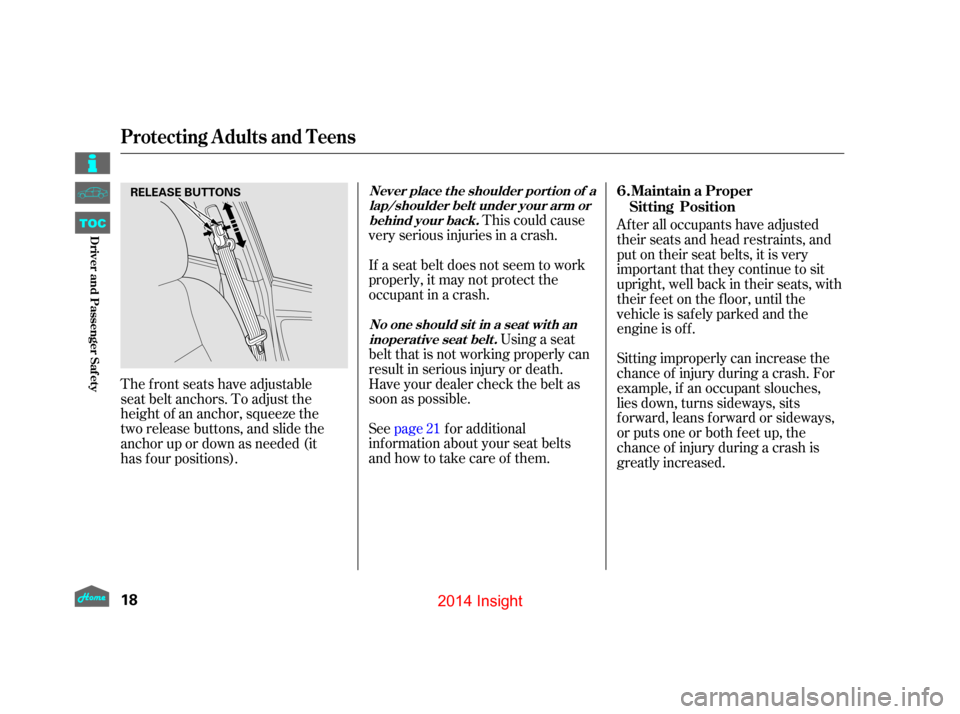
This could cause
very serious injuries in a crash.
If a seat belt does not seem to work
properly, it may not protect the
occupant in a crash.
Using a seat
belt that is not working properly can
result in serious injury or death.
Have your dealer check the belt as
soon as possible.
See page f or additional
inf ormation about your seat belts
and how to take care of them. Sitting improperly can increase the
chance of injury during a crash. For
example, if an occupant slouches,
lies down, turns sideways, sits
forward, leans forward or sideways,
or puts one or both f eet up, the
chance of injury during a crash is
greatly increased.
The front seats have adjustable
seat belt anchors. To adjust the
height of an anchor, squeeze the
two release buttons, and slide the
anchor up or down as needed (it
has four positions). After all occupants have adjusted
their seats and head restraints, and
put on their seat belts, it is very
important that they continue to sit
upright, well back in their seats, with
their feet on the floor, until the
vehicle is safely parked and the
engine is of f .
21 Maintain a Proper
Sitting Position
6.
Never place t he shoulder port ion of a
lap/shoulder belt under your arm orbehind your back.
No one should sit in a seat wit h aninoperat ive seat belt .
Protecting A dults and Teens
18
RELEASE BUTTONS
12/07/13 16:39:02 31TM8630_023
Driver and Passenger Saf etyTOC
2014 Insight
Page 22 of 411
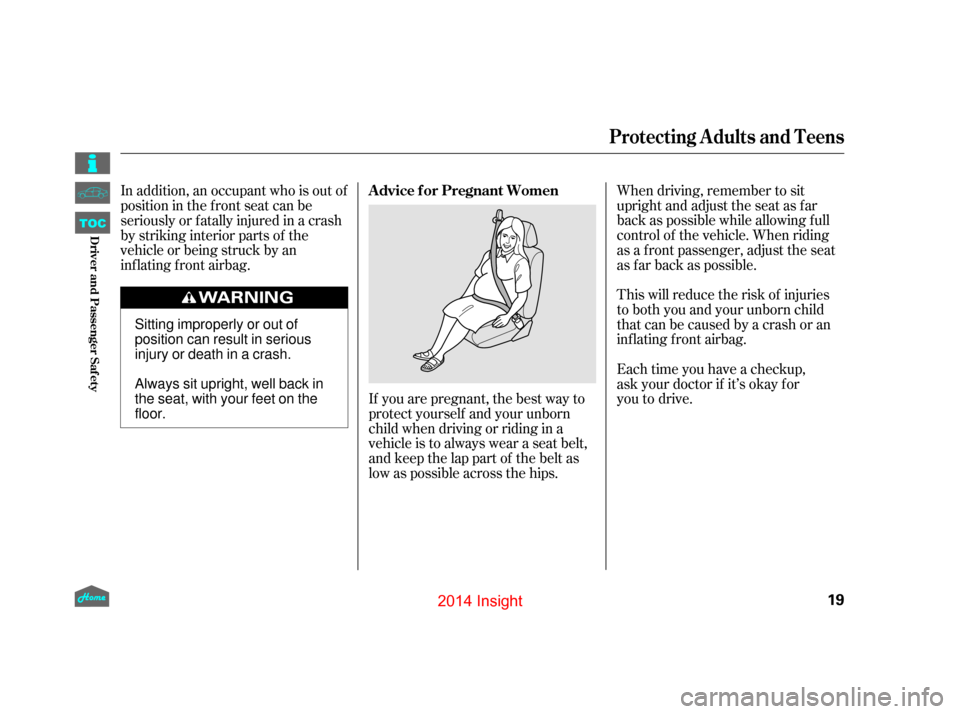
If you are pregnant, the best way to
protect yourself and your unborn
child when driving or riding in a
vehicle is to always wear a seat belt,
and keep the lap part of the belt as
low as possible across the hips.When driving, remember to sit
upright and adjust the seat as f ar
back as possible while allowing f ull
control of the vehicle. When riding
as a f ront passenger, adjust the seat
as far back as possible.
This will reduce the risk of injuries
to both you and your unborn child
that can be caused by a crash or an
inflating front airbag.
Each time you have a checkup,
ask your doctor if it’s okay for
you to drive.
In addition, an occupant who is out of
position in the f ront seat can be
seriously or f atally injured in a crash
by striking interior parts of the
vehicle or being struck by an
inflating front airbag.
Advice f or Pregnant Women
Protecting A dults and Teens
19
Sitting improperly or out of
position can result in serious
injury or death in a crash.
Always sit upright, well back in
the seat, with your feet on the
floor.
12/07/13 16:39:08 31TM8630_024
Driver and Passenger Saf etyTOC
2014 Insight
Page 23 of 411

Carrying hard or sharp
objects on your lap, or driving with
a pipe or other sharp object in
your mouth, can result in injuries
if your f ront airbag inf lates.
If they do, they
could be very seriously injured in a
crash.
Devices intended to improve
occupant comf ort or reposition the
shoulder part of a seat belt can
reduce the protective capability of
the seat belt and increase the
chance of serious injury in a crash. Objects on
the covers marked ‘‘SRS AIRBAG’’
could interf ere with the proper
operation of the airbags or be
propelled inside the vehicle and
hurt someone if the airbags inf late.
If your
hands or arms are close to an
airbag cover, they could be injured
if the airbag inf lates. If a side airbag or a
side curtain airbag inf lates, a cup
holder or other hard object
attached on or near the door could
be propelled inside the vehicle and
hurt someone.
If they do, they
could be very seriously injured in A passenger who is not
wearing a seat belt during a crash
or emergency stop can be thrown
against the inside of the vehicle,
against other occupants, or out of
the vehicle.
Improperly replacing
or covering f ront seat-back covers
can prevent your side airbags f rom
inf lating during a side impact.
Do not place hard or sharp object s
bet ween yourself and a f rontairbag.
T wo people should never use t he
same seat belt .
Do not put any accessories on seatbelts. Do not at t ach or place object s on
the f ront airbag covers.
K eep your hands and arms awayf rom t he airbag covers. Do not at t ach hard object s on or
near a door.
Never let passengers ride in t he cargo area or on t op of a f olded-down back seat . Passengers should not stand up or
change seats while the vehicle ismoving.
Do not cover or replace f ront seat -back covers wit hout consult ingyour dealer.Additional Saf ety Precautions
Protecting A dults and Teens
20
12/07/13 16:39:16 31TM8630_025
Driver and Passenger Saf etyTOC
a crash.
2014 Insight
Page 24 of 411
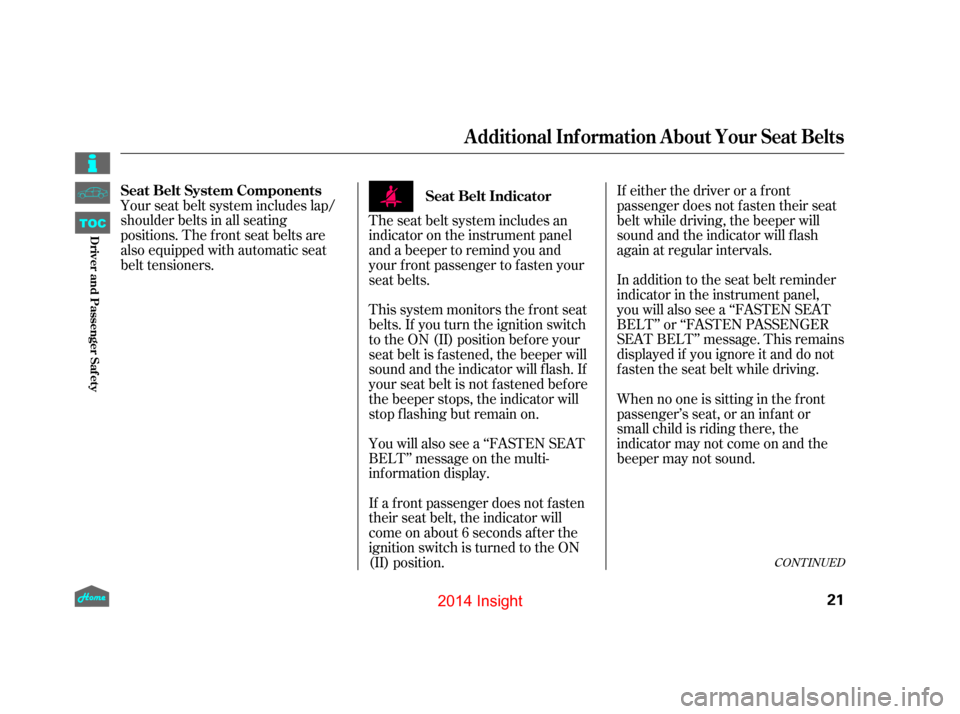
Your seat belt system includes lap/
shoulder belts in all seating
positions. The front seat belts are
also equipped with automatic seat
belt tensioners.In addition to the seat belt reminder
indicator in the instrument panel,
you will also see a ‘‘FASTEN SEAT
BELT’’ or ‘‘FASTEN PASSENGER
SEAT BELT’’ message. This remains
displayed if you ignore it and do not
f asten the seat belt while driving. If either the driver or a f ront
passenger does not f asten their seat
belt while driving, the beeper will
sound and the indicator will f lash
again at regular intervals.
The seat belt system includes an
indicator on the instrument panel
and a beeper to remind you and
your front passenger to fasten your
seat belts.
If a f ront passenger does not f asten
their seat belt, the indicator will
come on about 6 seconds af ter the
ignition switch is turned to the ON
(II) position. You will also see a ‘‘FASTEN SEAT
BELT’’ message on the multi-
inf ormation display. This system monitors the f ront seat
belts. If you turn the ignition switch
to the ON (II) position bef ore your
seat belt is f astened, the beeper will
sound and the indicator will f lash. If
your seat belt is not f astened bef ore
the beeper stops, the indicator will
stop f lashing but remain on.
When no one is sitting in the f ront
passenger’s seat, or an inf ant or
small child is riding there, the
indicator may not come on and the
beeper may not sound.
CONT INUED
Seat Belt System Components
Seat Belt Indicator
Additional Inf ormation About Your Seat Belts
21
12/07/13 16:39:24 31TM8630_026
Driver and Passenger Saf etyTOC
2014 Insight
Page 25 of 411
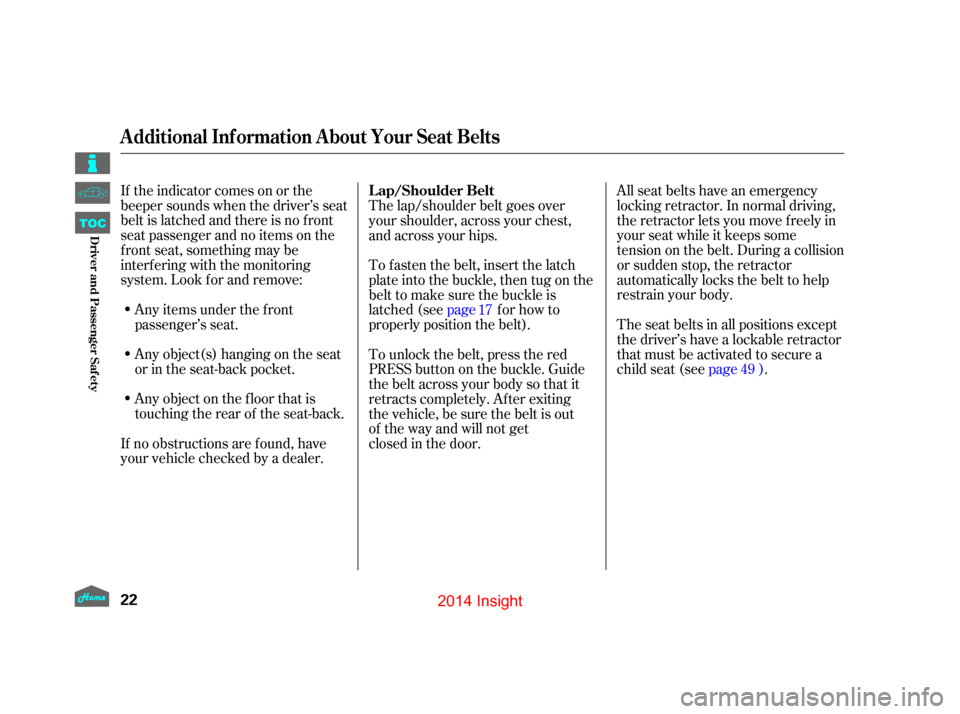
If the indicator comes on or the
beeper sounds when the driver’s seat
belt is latched and there is no f ront
seat passenger and no items on the
front seat, something may be
interf ering with the monitoring
system. Look f or and remove:Any items under the f ront
passenger’s seat.
Any object(s) hanging on the seat
or in the seat-back pocket.
Any object on the f loor that is
touching the rear of the seat-back.
If no obstructions are f ound, have
your vehicle checked by a dealer. All seat belts have an emergency
locking retractor. In normal driving,
the retractor lets you move f reely in
your seat while it keeps some
tension on the belt. During a collision
or sudden stop, the retractor
automatically locks the belt to help
restrain your body.
The lap/shoulder belt goes over
your shoulder, across your chest,
and across your hips.
To fasten the belt, insert the latch
plate into the buckle, then tug on the
belt to make sure the buckle is
latched (seepagef or how to
properly position the belt).
To unlock the belt, press the red
PRESS button on the buckle. Guide
the belt across your body so that it
retracts completely. After exiting
the vehicle, be sure the belt is out
of the way and will not get
closed in the door. The seat belts in all positions except
the driver’s have a lockable retractor
that must be activated to secure a
child seat (see
page ).
17
49
Additional Inf ormation About Your Seat Belts
L ap/Shoulder Belt
22
12/07/13 16:39:32 31TM8630_027
Driver and Passenger Saf etyTOC
2014 Insight
Page 26 of 411
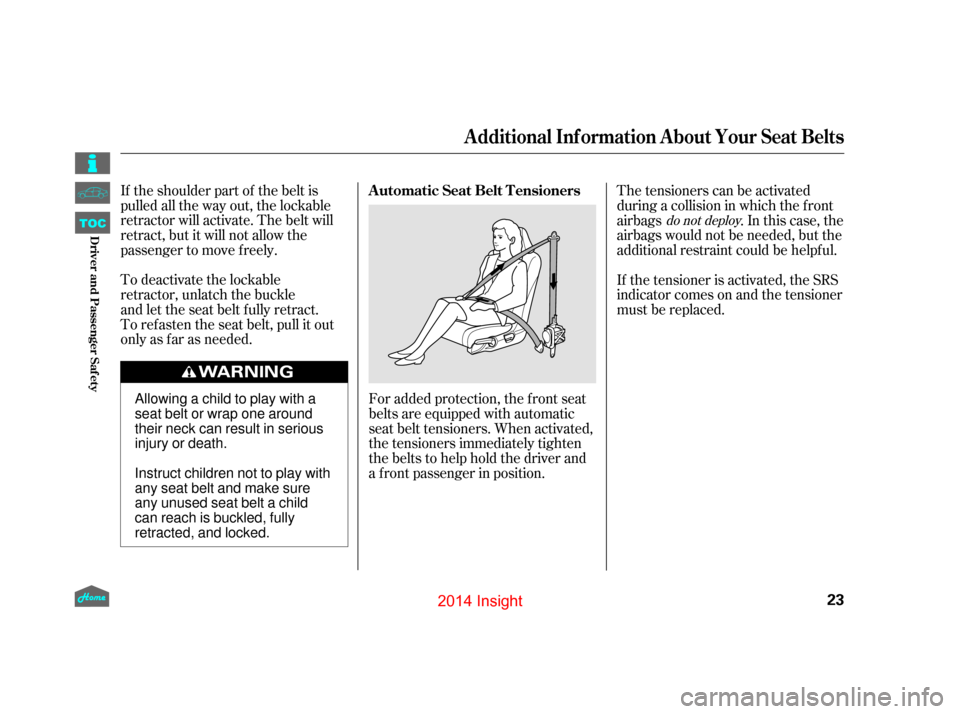
For added protection, the f ront seat
belts are equipped with automatic
seat belt tensioners. When activated,
the tensioners immediately tighten
the belts to help hold the driver and
a f ront passenger in position.
If the shoulder part of the belt is
pulled all the way out, the lockable
retractor will activate. The belt will
retract, but it will not allow the
passenger to move f reely.
To deactivate the lockable
retractor, unlatch the buckle
and let the seat belt fully retract.
To refasten the seat belt, pull it out
only as far as needed.
The tensioners can be activated
during a collision in which the f ront
airbags
. In this case, the
airbags would not be needed, but the
additional restraint could be helpf ul.
If the tensioner is activated, the SRS
indicator comes on and the tensioner
must be replaced.
do not deploy
Additional Inf ormation About Your Seat Belts
A utomatic Seat Belt T ensioners
23
Allowing a child to play with a
seat belt or wrap one around
their neck can result in serious
injury or death.
Instruct children not to play with
any seat belt and make sure
any unused seat belt a child
can reach is buckled, fully
retracted, and locked.
12/07/13 16:39:38 31TM8630_028
Driver and Passenger Saf etyTOC
2014 Insight
Page 27 of 411
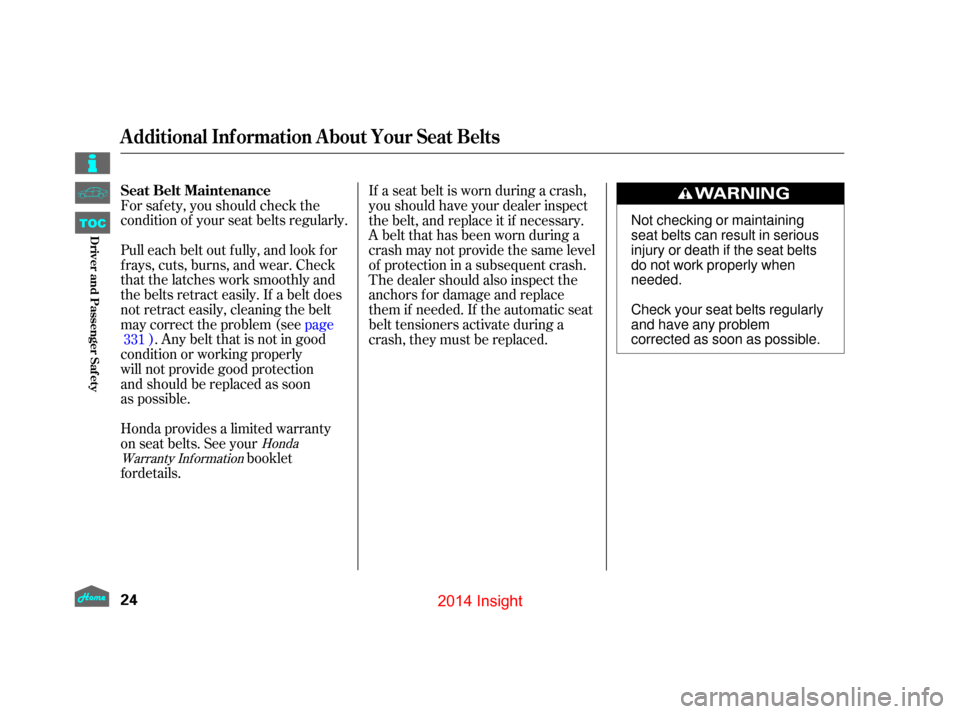
For saf ety, you should check the
condition of your seat belts regularly.
Pull each belt out fully, and look for
frays, cuts, burns, and wear. Check
that the latches work smoothly and
the belts retract easily. If a belt does
not retract easily, cleaning the belt
may correct the problem (seepage
) . Any belt that is not in good
condition or working properly
will not provide good protection
and should be replaced as soon
as possible.
Honda provides a limited warranty
on seat belts. See your bookletIf a seat belt is worn during a crash,
you should have your dealer inspect
the belt, and replace it if necessary.
A belt that has been worn during a
crash may not provide the same level
of protection in a subsequent crash.
The dealer should also inspect the
anchors f or damage and replace
them if needed. If the automatic seat
belt tensioners activate during a
crash, they must be replaced.
331
Honda
Warranty Inf ormation
Additional Inf ormation About Your Seat Belts
Seat Belt Maintenance
24
Not checking or maintaining
seat belts can result in serious
injury or death if the seat belts
do not work properly when
needed.
Check your seat belts regularly
and have any problem
corrected as soon as possible.
12/07/13 16:39:44 31TM8630_029
Driver and Passenger Saf etyTOC
for details.
2014 Insight
Page 28 of 411
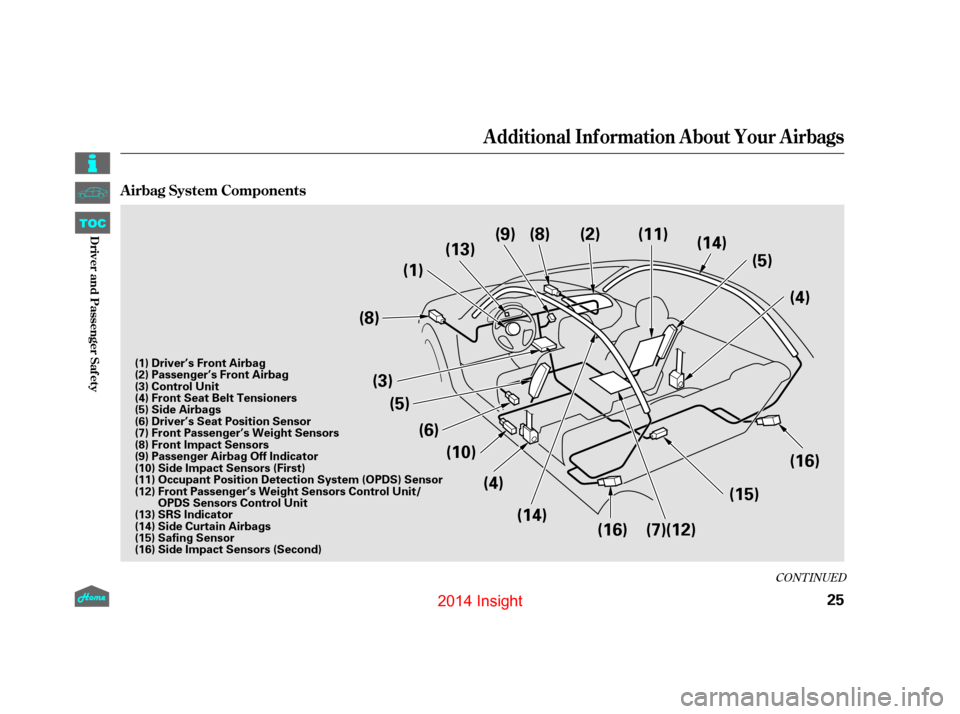
CONT INUED
A irbag System Components
Additional Inf ormation About Your Airbags
25
(1)
(3) (5)
(4)
(5)
(6)(10)
(13)
(9) (8)
(14)
(2)
(16) (4)
(15)
(16)
(14)
(8)
(11)
(7)(12)
(1) Driver’s Front Airbag
(2) Passenger’s Front Airbag
(3) Control Unit
(4) Front Seat Belt Tensioners
(5) Side Airbags
(6) Driver’s Seat Position Sensor
(7) Front Passenger’s Weight Sensors
(12) Front Passenger’s Weight Sensors Control Unit/ OPDS Sensors Control Unit
(13) SRS Indicator
(14) Side Curtain Airbags
(15) Safing Sensor
(16) Side Impact Sensors (Second) (8) Front Impact Sensors
(9) Passenger Airbag Off Indicator
(10) Side Impact Sensors (First)
(11) Occupant Position Detection System (OPDS) Sensor
12/07/13 16:39:51 31TM8630_030
Driver and Passenger Saf etyTOC
2014 Insight
Page 29 of 411
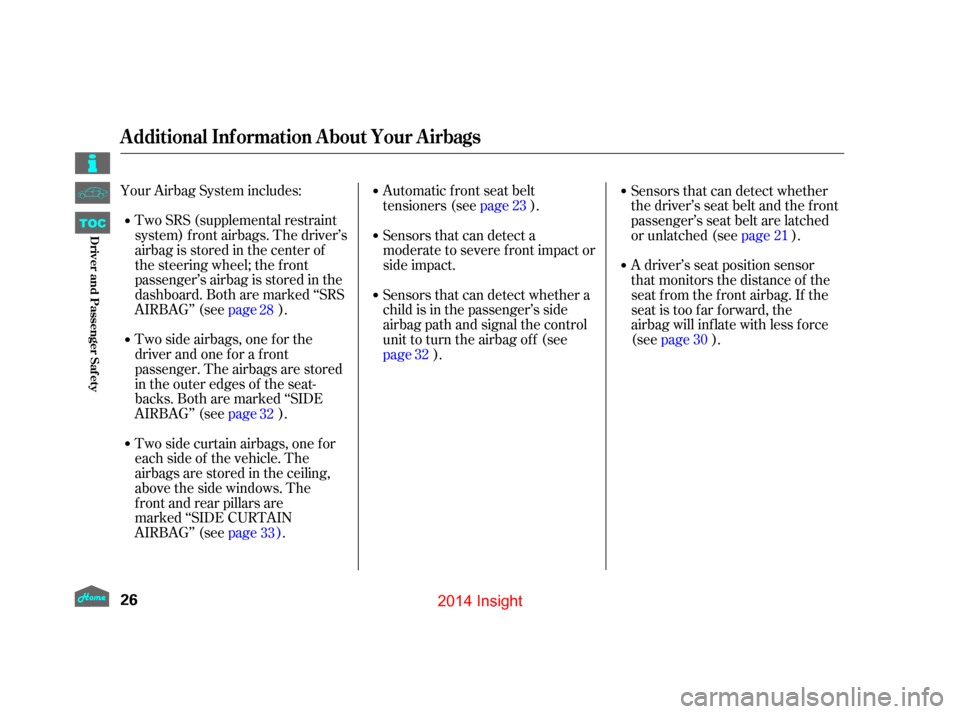
Your Airbag System includes:Two SRS (supplemental restraint
system) f ront airbags. The driver’s
airbag is stored in the center of
the steering wheel; the f ront
passenger’sairbagisstoredinthe
dashboard. Both are marked ‘‘SRS
AIRBAG’’ (see page).
Two side airbags, one f or the
driver and one f or a f ront
passenger. The airbags are stored
in the outer edges of the seat-
backs. Both are marked ‘‘SIDE
AIRBAG’’ (see page).
Two side curtain airbags, one for
each side of the vehicle. The
airbags are stored in the ceiling,
above the side windows. The
front and rear pillars are
marked ‘‘SIDE CURTAIN
AIRBAG’’ (see page). Automatic front seat belt
tensioners (see
page).
Sensors that can detect a
moderate to severe front impact or
side impact.
Sensors that can detect whether a
child is in the passenger’s side
airbag path and signal the control
unit to turn the airbag of f (see
page ). Sensors that can detect whether
the driver’s seat belt and the f ront
passenger’s seat belt are latched
or unlatched (see
page).
A driver’s seat position sensor
that monitors the distance of the
seat from the front airbag. If the
seat is too far forward, the
airbag will inflate with less force
(see page ).
28
32
33 23
32 21
30
Additional Inf ormation About Your Airbags
26
12/07/13 16:39:58 31TM8630_031
Driver and Passenger Saf etyTOC
2014 Insight
Page 30 of 411

An indicator on the instrument
panel that alerts you that the
passenger’s side airbag has been
turned of f (seepage).
An indicator on the dashboard that
alerts you that the passenger’s
f ront airbag has been turned of f
(see page ).
Emergency backup power in case
your vehicle’s electrical system is
disconnected in a crash.
Weight sensors that monitor the
weight on the f ront passenger’s
seat. If the weight is about 65
lbs (29 kg) or less (the weight
of an inf ant or small child), the
passenger’s f ront airbag will be
turned of f (see
page). A sophisticated electronic
system that continually monitors
and records information about
the sensors, the control unit, the
airbag activators, the seat belt
tensioners, and driver and front
passenger seat belt use
when the ignition switch is in the
ON (II) position.
An indicator on the instrument
panel that alerts you to a possible
problem with your airbag system
components (see
page). 34
35
34
30
Additional Inf ormation About Your Airbags
27
12/07/13 16:40:04 31TM8630_032
Driver and Passenger Saf etyTOC
2014 Insight